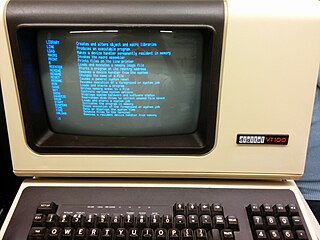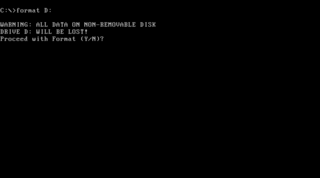Related Research Articles

In computing, dir (directory) is a command in various computer operating systems used for computer file and directory listing. It is one of the basic commands to help navigate the file system. The command is usually implemented as an internal command in the command-line interpreter (shell). On some systems, a more graphical representation of the directory structure can be displayed using the tree command.

fdisk is a command-line utility for disk partitioning. It has been part of DOS, DR FlexOS, IBM OS/2, and early versions of Microsoft Windows, as well as certain ports of FreeBSD, NetBSD, OpenBSD, DragonFly BSD and macOS for compatibility reasons. Windows 2000 and its successors have replaced fdisk with a more advanced tool called diskpart.

Windows 9x is a generic term referring to a series of Microsoft Windows computer operating systems produced from 1995 to 2000, which were based on the Windows 95 kernel and its underlying foundation of MS-DOS, both of which were updated in subsequent versions. The first version in the 9x series was Windows 95, which was succeeded by Windows 98 and then Windows Me, which was the third and last version of Windows on the 9x line, until the series was superseded by Windows XP.

In computing, XCOPY is a command used on IBM PC DOS, MS-DOS, IBM OS/2, Microsoft Windows, FreeDOS, ReactOS, and related operating systems for copying multiple files or entire directory trees from one directory to another and for copying files across a network.
In computing, Windows on Windows, was a compatibility layer of 32-bit versions of the Windows NT family of operating systems since 1993 with the release of Windows NT 3.1, which extends NTVDM to provide limited support for running legacy 16-bit programs written for Windows 3.x or earlier. There is a similar subsystem, known as WoW64, on 64-bit Windows versions that runs 32-bit programs.

In computing, exit is a command used in many operating system command-line shells and scripting languages.
In computing, FASTOPEN is a DOS terminate-and-stay-resident command, introduced in MS-DOS version 3.3, that provides accelerated access to frequently-used files and directories. The command is also available in SISNE plus.

In computing, tree is a recursive directory listing command or program that produces a depth-indented listing of files. Originating in PC- and MS-DOS, it is found in Digital Research FlexOS, IBM/Toshiba 4690 OS, PTS-DOS, FreeDOS, IBM OS/2, Microsoft Windows, and ReactOS. A version for Unix and Unix-like systems is also available.
In computing, DELTREE is a command line command in some Microsoft operating systems, SpartaDOS X and FreeDOS that recursively deletes an entire subdirectory of files.

In computing, ATTRIB is a command in Intel ISIS-II, DOS, IBM OS/2, Microsoft Windows and ReactOS that allows the user to change various characteristics, or "attributes" of a computer file or directory. The command is also available in the EFI shell.

In computing, the print command provides single-user print spooling capability in a number of operating systems. It is roughly similar to that provided by the UNIX System V lp and BSD lpr print spooler systems.

In computing, help is a command in various command line shells such as COMMAND.COM, cmd.exe, Bash, qshell, 4DOS/4NT, Windows PowerShell, Singularity shell, Python, MATLAB and GNU Octave. It provides online information about available commands and the shell environment.

In computing, format, a command-line utility that carries out disk formatting. It is a component of various operating systems, including 86-DOS, MS-DOS, IBM PC DOS and OS/2, Microsoft Windows and ReactOS.

In computing, choice is a command that allows for batch files to prompt the user to select one item from a set of single-character choices. It is available in a number of operating system command-line shells.

MS-DOS is an operating system for x86-based personal computers mostly developed by Microsoft. Collectively, MS-DOS, its rebranding as IBM PC DOS, and a few operating systems attempting to be compatible with MS-DOS, are sometimes referred to as "DOS". MS-DOS was the main operating system for IBM PC compatibles during the 1980s, from which point it was gradually superseded by operating systems offering a graphical user interface (GUI), in various generations of the graphical Microsoft Windows operating system.

Datalight was a privately held software company specializing in power failsafe and high performance software for preserving data integrity in embedded systems. The company was founded in 1983 by Roy Sherrill, and is headquartered in Bothell, Washington. As of 2019 the company is a subsidiary of Tuxera under the name of Tuxera US Inc.
In computing, diskcopy is a command used on a number of operating systems for copying the complete contents of a diskette to another diskette.
In computing, recover is a primitive file system error recovery utility included in MS-DOS / IBM PC DOS versions prior to DOS 6.0 and a number of other operating systems.
In computing, diskcomp is a command used for comparing the complete contents of a floppy disk to another one.
The command-line tool exe2bin is a post-compilation utility program available on MS-DOS and other operating systems.
References
- ↑ Jamsa, Kris A. (1993), DOS: The Complete Reference, Osborne McGraw-Hill, p. 206, ISBN 0078819040.
- ↑ "DOS Command: SHARE".
- ↑ MS-DOS and Windows command line share command
- ↑ Wolverton, Van (2003). Running MS-DOS Version 6.22 (20th Anniversary Edition), 6th Revised edition. Microsoft Press. ISBN 0-7356-1812-7.
- ↑ "FreeDOS 1.2 Updates Group - FreeDOS Base". Ibiblio.org. Retrieved 2022-09-08.
- ↑ "PTS-DOS 2000 Pro User Manual" (PDF). Buggingen, Germany: Paragon Technology GmbH. 1999. Archived (PDF) from the original on 2018-05-12. Retrieved 2018-05-12.
- ↑ SISNE plus - Referência Sumária | Datassette
- ↑ "FreeDOS 1.2 Updates Package - share (FreeDOS Base)". Ibiblio.org. 2007-10-20. Retrieved 2022-09-08.
- ↑ DR DOS 6.0 User Guide Optimisation and Configuration Tips
- ↑ "Datalight ROM-DOS User's Guide" (PDF). www.datalight.com.
- ↑ MS-DOS subsystem commands